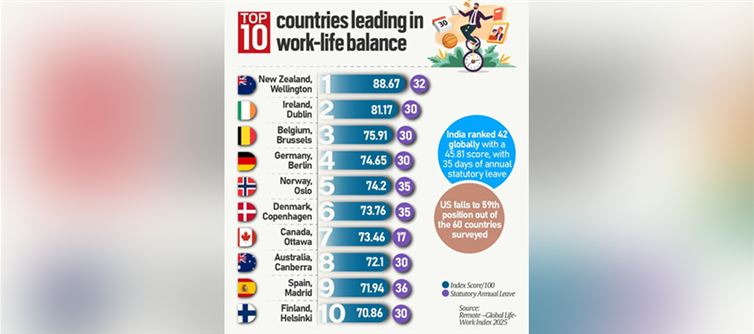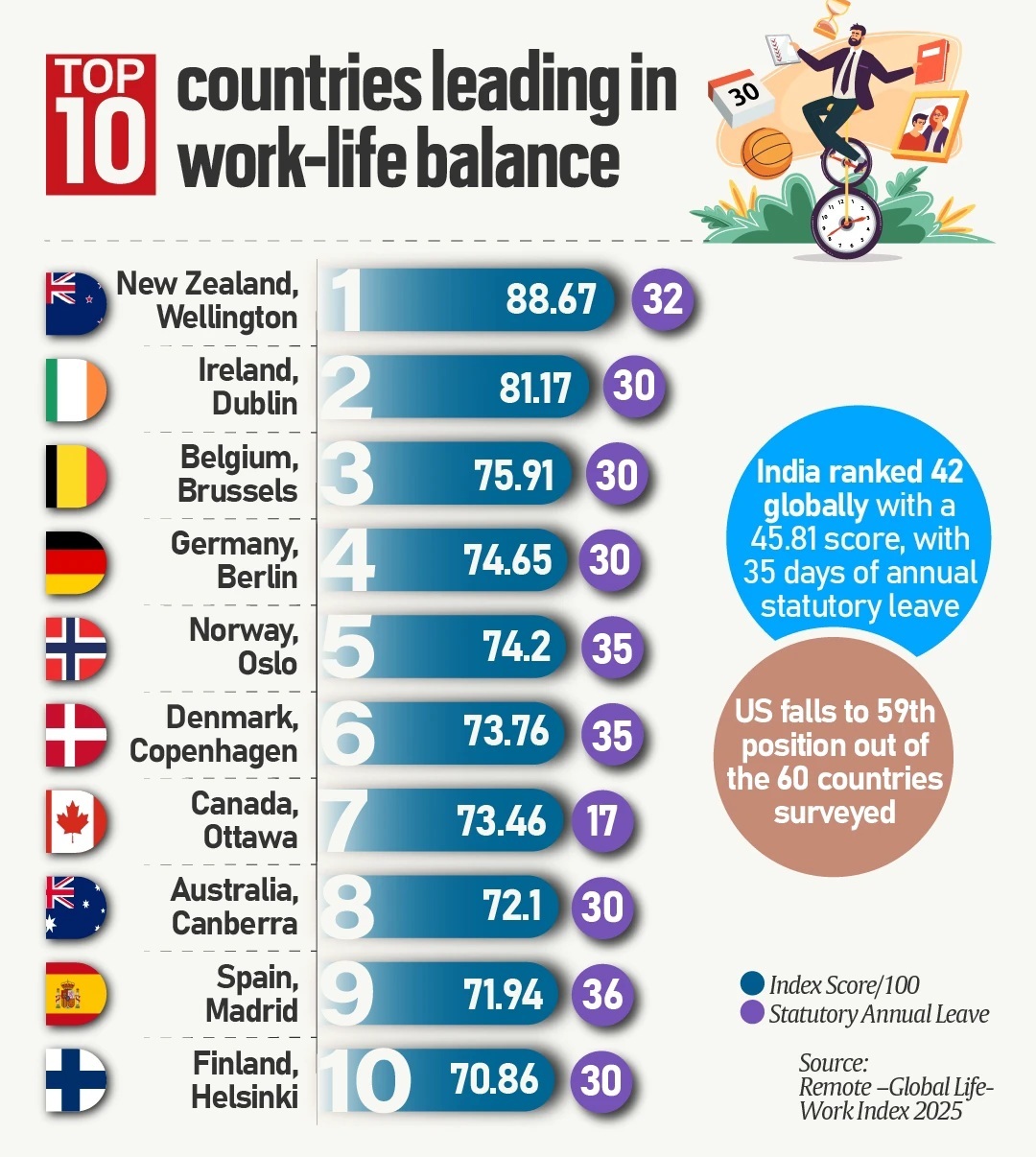
A recent infographic, highlighting the top 10 countries leading in work-life balance as of 2025, has drawn significant attention to global disparities in employee well-being. Based on the Global Life-Remote Work Index 2025, the data reveals new zealand topping the list with an impressive index score of 88.67, while the united states falls to a disappointing 59th place among the 60 countries surveyed. Released as of 11:12 AM IST on July 8, 2025, this ranking underscores the varying approaches nations take toward balancing work and personal life, with statutory leave policies playing a key role. The infographic, adorned with playful imagery of a man juggling work and leisure, offers a snapshot of how countries like new zealand, ireland, and belgium excel, while others, including india and the US, face challenges.
 New Zealand, with its capital Wellington, leads the pack with an index score of 88.67 and a generous 32 days of statutory annual leave, setting a high standard for work-life integration. ireland (Dublin) follows closely with a score of 81.17 and 30 days of leave, while belgium (Brussels) secures third place with 75.91 and an identical 30-day leave policy. Other standout nations include germany (Berlin) at 74.65 with 30 days, norway (Oslo) at 74.2 with 35 days, denmark (Copenhagen) at 73.76 with 35 days, canada (Ottawa) at 73.46 with 17 days, australia (Canberra) at 72.1 with 30 days, spain (Madrid) at 71.94 with 36 days, and finland (Helsinki) at 70.86 with 30 days.
New Zealand, with its capital Wellington, leads the pack with an index score of 88.67 and a generous 32 days of statutory annual leave, setting a high standard for work-life integration. ireland (Dublin) follows closely with a score of 81.17 and 30 days of leave, while belgium (Brussels) secures third place with 75.91 and an identical 30-day leave policy. Other standout nations include germany (Berlin) at 74.65 with 30 days, norway (Oslo) at 74.2 with 35 days, denmark (Copenhagen) at 73.76 with 35 days, canada (Ottawa) at 73.46 with 17 days, australia (Canberra) at 72.1 with 30 days, spain (Madrid) at 71.94 with 36 days, and finland (Helsinki) at 70.86 with 30 days.
The index score, measured out of 100, reflects a combination of factors such as working hours, leave entitlements, and workplace flexibility, while statutory annual leave highlights the legal minimum vacation time guaranteed to employees. This data suggests that northern and western european countries, alongside Commonwealth nations, dominate the top tier due to robust labor policies.
The infographic also provides context for countries outside the top 10, noting India’s 42nd ranking with a score of 45.81 and 35 days of statutory leave, indicating a moderate balance despite a lower overall index. This placement reflects India’s growing workforce flexibility, though cultural and economic factors may limit its score. In stark contrast, the United States’ 59th position highlights a significant lag, likely due to limited statutory leave—typically zero mandated days at the federal level—and a culture of long working hours. The survey’s coverage of 60 countries underscores a global trend where nations with higher leave entitlements and supportive policies tend to rank higher.
The Global Life-Remote Work Index 2025 paints a clear picture of work-life balance leadership, with new zealand setting the gold standard and the US trailing far behind. The top 10 countries’ high index scores and substantial leave policies highlight the benefits of prioritizing employee well-being, while India’s mid-tier ranking and the US’s low standing point to areas needing improvement.
 New Zealand, with its capital Wellington, leads the pack with an index score of 88.67 and a generous 32 days of statutory annual leave, setting a high standard for work-life integration. ireland (Dublin) follows closely with a score of 81.17 and 30 days of leave, while belgium (Brussels) secures third place with 75.91 and an identical 30-day leave policy. Other standout nations include germany (Berlin) at 74.65 with 30 days, norway (Oslo) at 74.2 with 35 days, denmark (Copenhagen) at 73.76 with 35 days, canada (Ottawa) at 73.46 with 17 days, australia (Canberra) at 72.1 with 30 days, spain (Madrid) at 71.94 with 36 days, and finland (Helsinki) at 70.86 with 30 days.
New Zealand, with its capital Wellington, leads the pack with an index score of 88.67 and a generous 32 days of statutory annual leave, setting a high standard for work-life integration. ireland (Dublin) follows closely with a score of 81.17 and 30 days of leave, while belgium (Brussels) secures third place with 75.91 and an identical 30-day leave policy. Other standout nations include germany (Berlin) at 74.65 with 30 days, norway (Oslo) at 74.2 with 35 days, denmark (Copenhagen) at 73.76 with 35 days, canada (Ottawa) at 73.46 with 17 days, australia (Canberra) at 72.1 with 30 days, spain (Madrid) at 71.94 with 36 days, and finland (Helsinki) at 70.86 with 30 days.The index score, measured out of 100, reflects a combination of factors such as working hours, leave entitlements, and workplace flexibility, while statutory annual leave highlights the legal minimum vacation time guaranteed to employees. This data suggests that northern and western european countries, alongside Commonwealth nations, dominate the top tier due to robust labor policies.
The infographic also provides context for countries outside the top 10, noting India’s 42nd ranking with a score of 45.81 and 35 days of statutory leave, indicating a moderate balance despite a lower overall index. This placement reflects India’s growing workforce flexibility, though cultural and economic factors may limit its score. In stark contrast, the United States’ 59th position highlights a significant lag, likely due to limited statutory leave—typically zero mandated days at the federal level—and a culture of long working hours. The survey’s coverage of 60 countries underscores a global trend where nations with higher leave entitlements and supportive policies tend to rank higher.
The Global Life-Remote Work Index 2025 paints a clear picture of work-life balance leadership, with new zealand setting the gold standard and the US trailing far behind. The top 10 countries’ high index scores and substantial leave policies highlight the benefits of prioritizing employee well-being, while India’s mid-tier ranking and the US’s low standing point to areas needing improvement.




 click and follow Indiaherald WhatsApp channel
click and follow Indiaherald WhatsApp channel